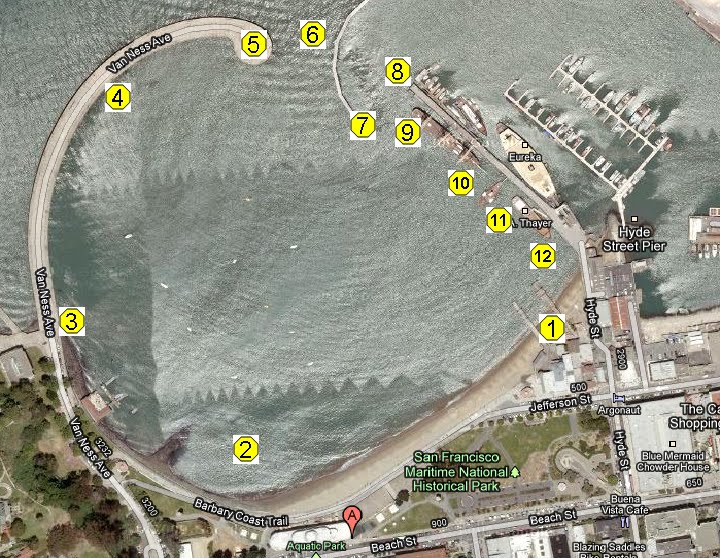Sunday 04/04/10
The English Channel is often cited as one of the busiest shipping straits in the world. A quick glance at the website depicting live English Channel Ship Movements easily confirms that a west-east crossing will encounter many moving obstacles. And these moving obstacles can be quite large—sometimes reaching the equivalent of three American football fields. A multitude of these football fields steam north and south at up to thirty-five miles an hour and can take miles to turn or stop. In short, just as they do in San Francisco Bay, the big boys have the right of way.
Often, these floating behemoths carry hazardous materials making collision avoidance a high priority. To keep order, the International Maritime Organization has established a Traffic Separation Scheme. A set of buoys delineate an aquatic superhighway in the Channel with northbound traffic staying to the east and southbound traffic staying to the west. A daily dose of ferry and drayage traffic runs east and west across the grain of shipping creating a veritable enforcement headache for the authorities.
Since the superhighway straddles international boundaries, the traffic cops are multi-national as well. And the fines can be steep. In October, 2000, the Dover Coastguard cited a sailboat captain for violating the rules resulting in ₤15,000 in fines. On the French side of Le Manche, the marine sheriff is the Centre Régional Opérational de Surveillance et de Sauvetage Gris Nez. CROSS Gris Nez is the more manageable appellation for the French Coastguard.
The Maritime and Coastguard agency of England publishes a handy guide to “unconventional crossings of the Dover Strait in unorthodox craft.” The guide points out that the Maritime Prefect of the Channel and North Sea has issued an order number 14/93 which expressly forbids swimming in the French side of the traffic separation scheme. The order allows for two exceptions: events organized and approved by either the Channel Swimming Association (CSA) or Channel Swimming and Pilots Federation (CS&PF). Thus, searching for someone to pilot a swim across the English Channel is fairly easy. Just visit the two websites and look up the contact information.
About 16 pilots are registered with either the CSA or the CS&PF. Each pilot provides evidence of qualifications, insurance, boat certification and inspections to satisfy the necessary organization standards. While pilot fees vary, a solo crossing attempt will cost in the neighborhood of ₤2,100 pounds. Most pilots require a ₤1,000 payment in advance which is non-refundable under normal circumstances. This fee covers what amounts to a twenty-four hour workday for the pilot and crew on the day of the swim. First, the swim itself will take from eight to twenty hours. Then, loading and preparing the boat; motoring to the starting location; retrieving the swimmer on the other end; motoring back to England; and unloading, refueling, and securing the boat adds a surprising amount of time. This doesn’t count the time the pilot and crew spend on standby waiting for the weather window to clear or shuffling paperwork and dealing with cancellations and other swimmer interactions.
The fees for boat surveys and inspections, commercial certifications, examinations, insurance, fuel and repairs are the owner’s responsibility. The wages for the one or two crew members also come out of the ₤2,100. Most of the boats come equipped with sophisticated electronic equipment suitable for the open ocean including radar, Loran, GPS navigation, depth finder, and communication devices. As any boat owner will testify, all of these gadgets tend to break giving rise to the definition of a water craft as “a hole in the water into which you throw money.”
While the pilot fee is the largest direct outlay, both swimming associations assess their own, separate charges. For the Channel Swimming Association, these break down as follows:
Associate membership ₤21
Swim registration fee 39
Administration fee 170
Ratification fee 160
Total ₤390
The ratification fee covers the cost for an official observer who rides in the boat, keeps a log, and verifies that the swimmer follows the general rules governing a certified crossing. The observer will make sure that the swim gear, any medications used, the start, the crossing, and the finish all adhere to the requirements. The observer will also keep the official crossing time. CS&PF fees are slightly less.
Indirect costs include a physical examination with an electrocardiogram (ECG). The attending physician must complete a medical certificate testifying to the fitness of the individual to undertake a Channel swim. Travel and lodging are big ticket items for aspirants who don’t live in England. Swim food and lights add a few dollars.
Lindsay and I budgeted substantially more for this adventure than we would for a normal vacation. On the other hand, when we decided to undertake this challenge, we agreed that it represented a potential lifetime achievement. So far, it’s already paying dividends in education, relationships, entertainment, and raw personal growth and satisfaction. And anyway, it’s cheaper than climbing Mt. Everest.
4 years ago


No comments:
Post a Comment